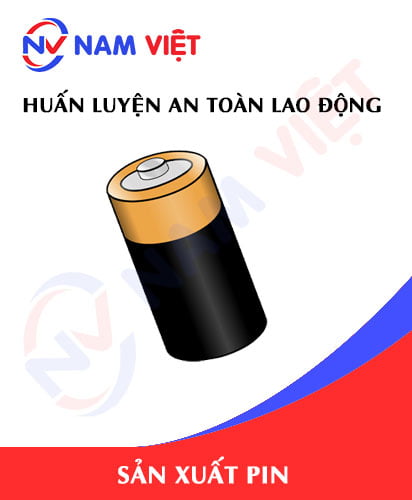Occupational Safety Training for Battery Manufacturing
99,000 ₫
Note: The above price is calculated for one person, the price may fluctuate depending on the number of trainees attending the course and market movements. For more accurate pricing support, please refer to the price list or contact our consulting staff directly.
Occupational safety is an important issue in factory manufacturing batteries and needs to be addressed promptly to ensure the health and safety of workers, as well as enhance the reputation of businesses. The Occupational Safety Training course is one of the effective solutions to raise awareness of how to prevent workplace accidents for employees participating in battery manufacturing.
Table of Contents
Toggle1. Overview of Batteries
a. What is a battery?
- A battery (also called an accumulator) is a device that stores electrical energy in chemical form and converts it into electrical energy when needed. Batteries are widely used in daily life and production to provide power for mobile devices, computers, medical equipment, and other electronic systems. Common types of batteries today include alkaline batteries, lithium-ion batteries, lead-acid batteries, and nickel-metal hydride (NiMH) batteries.
- Currently, the battery manufacturing industry in Vietnam is developing, especially with the increasing demand for batteries in daily life and production. Battery companies in Vietnam have invested in modern equipment and new technologies to improve product quality and increase production capacity.
- According to the 2021 Battery Market Research Report by Q&Q Market Research, the battery manufacturing industry in Vietnam has experienced significant growth in recent years. It is forecasted that by 2026, the industry will continue to grow with an average annual growth rate of about 12.5%.

b. Battery manufacturing machinery
The battery manufacturing process involves multiple steps and uses various types of machinery and equipment. Some main machines and equipment used in battery production include:
- Hot rolling machines: used to roll flat battery sheets, creating the plate structure of the battery.
- Cutting machines: used to cut battery plates to appropriate sizes for different types of batteries.
- Pressing machines: used to press the battery plates together.
- Assembly machines: used to assemble battery plates, including installing positive and negative terminals and interconnecting the plates.
- Enclosure machines: used to seal the battery casing after assembly.
- Testing machines: used to check the quality and performance of batteries.
Other equipment includes charging machines, waste treatment machines, packing machines, and production process control equipment to ensure product quality.

c. Prominent battery manufacturers in Vietnam
Some notable battery manufacturers in Vietnam are:
- Panasonic Energy Vietnam: A 100% Panasonic-owned company in Vietnam, specializing in alkaline batteries, lithium batteries, manganese batteries, rechargeable batteries, watch batteries, and various types of accumulators.
- GS Battery Vietnam: A 100% subsidiary of GS Battery Korea, producing lead-acid batteries, dry batteries, solar batteries, accumulators, and power batteries.
- Vietchem Battery: Produces general-purpose batteries, alkaline batteries, rechargeable batteries, manganese batteries, lithium batteries, and power batteries.
- An Phú Battery: Produces and trades lead-acid batteries, dry batteries, automotive batteries, power batteries, and accumulators.
- Trung Nam Group: A large battery manufacturing group in Vietnam, specializing in dry batteries, lead-acid batteries, rechargeable batteries, watch batteries, and power batteries.
- Saigon Storage Battery: Produces lead-acid batteries, dry batteries, motorcycle batteries, accumulators, power batteries, and related products.
- Dong Nai Storage Battery: Produces automotive batteries, lead-acid batteries, power batteries, accumulators, and related products.
- Viet Trung Battery: Produces dry batteries, lead-acid batteries, power batteries, and accumulators.
- Hanel Battery: Produces lead-acid batteries, dry batteries, rechargeable batteries, and power batteries.
- Dongjin Vietnam Battery: Produces and trades dry batteries, lead-acid batteries, rechargeable batteries, and various types of power batteries.
d. Specific roles in a battery manufacturing plant
Group 1
- CEO, Deputy CEO, and department heads in the battery manufacturing plant.
Group 2
- Safety officers: manage safety in the plant, design safety procedures, and monitor employees to ensure compliance with safe working processes.
Group 3
- Battery component production: The plant produces components such as circuit boards, conduits, metal plates, terminals, plastic casings, electrodes, electrolytes, etc.
- Assembly and testing: Components are assembled into finished products, then tested to ensure quality.
- Charging: Batteries are charged before packaging and shipping.
- Packing and shipping: After testing and charging, batteries are packed and delivered to customers or retailers.
- Repair and recycling: Used batteries can be repaired and recycled for reuse.
Group 4
- Office, service, sales, and marketing roles.
- Production management, quality management, human resource management, material management, and financial accounting management.
- Research and development of new products, designing product packaging and appearance.

e. Types of batteries currently in use worldwide
Currently, many types of batteries are used globally, including:
- Lithium-ion batteries: The most widely used type today in electronics, cars, e-bikes, and energy storage systems. They have higher energy density, long service life, and are rechargeable multiple times.
- Lead-acid batteries: Traditional batteries used in household electronics, watches, toys, and positioning devices. However, they can pollute the environment due to toxic chemicals.
- Nickel-cadmium (Ni-Cd) batteries: Used in electronics, toys, and e-bikes. They contain harmful cadmium, posing risks to health and environment, so their use has been restricted.
- Nickel-metal hydride (Ni-MH) batteries: Have higher energy density than lead-acid batteries but lower performance compared to lithium-ion batteries.
- Other types: Zinc-carbon, alkaline, zinc-air, silver-zinc batteries, etc., depending on specific applications.
2. Overview of occupational safety training for battery production
This article focuses on Group 3, as Group 3 directly participates in production and faces the highest occupational safety risks. See other groups here.
a. What is Group 3 occupational safety training?
- Group 3 occupational safety training consists of sessions that equip workers with awareness on preventing workplace accidents.
- The training helps workers recognize and avoid hazards, reducing risks of accidents during work.
REGISTER FOR OCCUPATIONAL SAFETY TRAINING SERVICE
b. Training duration
Initial occupational safety training
- Total training duration is at least 24 hours, including examination time.
- 8 hours theory on occupational safety and hygiene policies and laws
- 8 hours theory on basic occupational safety and hygiene knowledge
- 4 hours theory on specialized training content
- 2 hours practical on specialized training content
- 2 hours final theoretical examination
The training center will schedule multiple sessions depending on workers’ availability. Typically, there are 6 sessions over 3 days, provided the manufacturer arranges continuous training time.
Periodic occupational safety training
- Before the occupational safety card expires, workers who want renewal must complete periodic occupational safety training, with a duration at least 50% of the initial training duration.
Explanation: The total duration of periodic occupational safety training is at least 12 hours, including examination. After completing the course and passing the exam, workers will have their occupational safety card renewed.
c. Training content
| No. | TRAINING CONTENT | TRAINING HOURS | |||
| Total | Including | ||||
| Theory | Practical | Examination | |||
| I | Policies and laws on occupational safety and hygiene | 8 | 8 | 0 | 0 |
| 1 | Overview of regulations and legal framework on occupational safety and hygiene. | 6 | 6 | ||
| 2 | System of standards and technical regulations for occupational safety and hygiene. | 1 | 1 | ||
| 3 | Specific regulations by authorities on occupational safety and hygiene during construction, expansion, or renovation of facilities and production, use, storage, or inspection of machines, equipment, materials, or substances with strict safety requirements. | 1 | 1 | ||
| II | Basic knowledge on occupational safety and hygiene | 8 | 8 | 0 | 0 |
| 1 | Basic knowledge of hazards and harmful factors at the workplace. | 4 | 4 | ||
| 2 | Methods to improve working conditions. | 1 | 1 | ||
| 3 | Safety culture in production and business. | 1 | 1 | ||
| 4 | Rights and duties of employers and employees; policies on occupational safety and hygiene; functions and duties of the safety network. | 1 | 1 | ||
| 5 | Safety regulations, signs, safety instructions, use of protective equipment, first aid skills, and occupational disease prevention. | 1 | 1 | ||
| III | Specialized training content | 6 | 4 | 2 | 0 |
| Comprehensive knowledge of machines, equipment, hazardous substances; risk assessment and management; safe working procedures for machines, equipment, and hazardous substances. | 6 | 4 | 2 | ||
| IV | Final occupational safety examination | 2 | 2 | 0 | 0 |
| Total | 24 | 22 | 2 | ||
See more training content for all 6 groups
d. Occupational safety card
After completing the occupational safety training and passing the exam, workers will be issued a safety card (commonly called a Group 3 occupational safety certificate).
The Group 3 card shows details such as full name, date of birth, job, and specific work environment, as well as training duration, red stamp, and signature confirming completion.
According to Clause 2 of Article 24, Decree 44/2016/ND-CP, there are two cases:
- If the employer and employee have a labor contract, the employer must sign, stamp, and seal the safety card for Group 3 workers after completing the training and passing the exam.
- If the worker is freelance or temporary and does not have a labor contract, the training unit must sign, stamp, and seal the safety card after the worker completes the training and passes the exam.

3. Identifying Hazards Affecting Workers in Battery Manufacturing
Battery manufacturing can present several hazards to workers, including:
- The production of li-ion batteries and lithium polymer (LiPo) batteries requires the use of flammable liquids and gases such as ethylene carbonate, dimethyl carbonate, ethyl methyl carbonate, vinylene carbonate, ethylene oxide, propylene oxide, isopropyl alcohol, ethyl acetate, n-butyl acetate, n-methyl pyrrolidone, and butylene carbonate. Improper handling of these substances can lead to fire and explosion risks, posing threats to workers’ lives.
- Battery production can also pose health hazards to workers if they are exposed to toxic chemicals such as lithium, cobalt, nickel, and manganese. Exposure to these substances can cause health issues including headaches, fatigue, sore throat, coughing, difficulty breathing, and chest pain. Long-term exposure may lead to more serious health problems, including pneumonia and cancer.
- Battery production staff may work in factory environments with large machinery and powerful engines. Failure to follow safety procedures when operating and maintaining this equipment can result in serious injuries or even fatalities.
- Some battery manufacturing processes may involve the use of radiation, for example, during the heating of battery cells and their recycling preparation. Improper protection against these radiation sources can harm workers’ health.
4. Common Workplace Accidents in Battery Manufacturing
Common workplace accidents during battery manufacturing include:
- Fire and explosion accidents: These are among the most dangerous accidents and often occur when chemicals leak or spill from batteries and contact air. Without proper management and operation, flammable liquids and gases can cause serious accidents, including fire or explosion.
- Electrical accidents: Battery production also involves electrical hazards, including electric shocks or the effects of current on electronic devices. These accidents can cause serious injury or even death.
- Physical accidents: Li-ion and lithium polymer (LiPo) battery production often requires complex machinery and equipment for production, testing, and packaging. Workers may be injured if they do not follow safety procedures, leading to cuts, punctures, crushing, or impact injuries.
- Radiation-related accidents: Battery manufacturing may involve the use of radiation to test and heat battery cells. Improper protection can pose health risks to workers.
- Chemical accidents: Battery production requires various chemicals and additives. Exposure to these substances can cause serious health issues, including pneumonia and cancer.

5. Safety Measures for Participating in Battery Manufacturing
To ensure worker safety during battery production, manufacturers should implement the following safety measures:
- Training and instruction: Battery production staff need to be trained on safe work procedures, personal protective equipment usage, and management of hazardous chemicals. Ensure all employees understand the effects of workplace hazards and know how to prevent and mitigate risks.
- Use of personal protective equipment (PPE): Workers should be provided with appropriate PPE, including helmets, safety goggles, masks, gloves, and protective shoes. Ensure that equipment is suitable for the specific tasks and used correctly.
- Safe working conditions: Manufacturers must ensure safe working conditions in the factory, including lighting, temperature, humidity, and ventilation. Work areas must also be protected and clean.
- Hazardous chemical management: Manufacturers should safely manage hazardous chemicals, including storage, transport, and waste handling. Workers must understand the risks of these chemicals and how to prevent and reduce them.
- Equipment inspection and maintenance: Regularly inspect and maintain factory equipment to ensure safe and efficient operation. Ensure equipment is used and stored properly.
- Periodically conduct workplace environmental monitoring in the factory, collect and analyze harmful factors affecting workers, and adjust to reduce risks to prevent occupational diseases.
6. Benefits of Battery Manufacturing Safety Training
An Toan Nam Viet provides the following benefits to businesses after completing safety training courses in accordance with Decree 44/2016/ND – CP on occupational health and safety:
- Workers can identify potential hazards and take preventive measures to avoid workplace accidents.
- Businesses can establish risk prevention measures in production, operation, and maintenance processes.
- Reduce costs related to potential workplace safety hazards.
- Continuous production improves labor productivity and product quality.
- Comply with labor safety laws, avoiding legal risks.
- Enhance professionalism and reputation, strengthening the company brand.
Nam Viet’s training courses help individuals avoid external hazards that could lead to injury or even death.
REGISTER FOR OCCUPATIONAL SAFETY TRAINING SERVICES
7. Customer Feedback After Completing Battery Manufacturing Safety Training
An Toan Nam Viet has many years of experience accompanying businesses in Vietnam, especially in the southern provinces. This responsibility is extremely valuable, and therefore Nam Viet’s Occupational Safety Training is increasingly professional. The motivation behind Nam Viet’s growth comes from positive feedback and suggestions from businesses. Below are some testimonials from our partners.
Bac Nam E&C Investment and Construction Joint Stock Company
“The first time using An Toan Nam Viet’s service, I was surprised by the 24/7 support from the consulting team. Class organization was fast and convenient for our company. Thank you very much for Nam Viet’s service!”
See more customer interviews after using An Toan Nam Viet services
8. An Toan Nam Viet’s Occupational Safety Training Capacity
An Toan Nam Viet is a reputable and quality occupational safety training center in Vietnam. Continuous training sessions are conducted at production workshops, factories, or construction sites across the country (all 63 provinces of Vietnam).
REGISTER FOR OCCUPATIONAL SAFETY TRAINING SERVICES
Occupational Safety Training License
- An Toan Nam Viet has been inspected and certified by the Department of Occupational Safety of the Ministry of Labor – Invalids and Social Affairs and granted a certificate confirming the eligibility to conduct occupational safety and hygiene training. This further strengthens our training capabilities.

Training Materials and Lectures
- Before being used in OST courses, training materials are reviewed to ensure knowledge accuracy and practical effectiveness.
- Teaching methods are standardized according to An Toan Nam Viet standards, developed by occupational safety experts to maximize learning efficiency for trainees.
Facilities
- Controlling classroom factors affects training efficiency and learning effectiveness.
- Our training facilities provide spacious classrooms meeting standards for area, lighting, and training equipment.
9. Nationwide Reputable Safety Training Center
At An Toan Nam Viet, we prioritize occupational safety training with dedication. Our mission is to equip workers with knowledge to protect themselves, contributing to national development.
To ensure training effectiveness, we meticulously prepare every detail, from teaching tools, equipment, curriculum, materials, to audio and lighting.
Our instructors are experts with many years of experience. They have research projects identifying hazards across industries and methods for prevention.
Lectures are based on practical experience and delivered vividly and clearly, ensuring learners comfortably acquire knowledge. All instruction adheres to Decree 44/2016/ND-CP.
Workers learn hazard prevention measures and how to protect themselves, applying them appropriately in real work situations.
Our training center proudly provides professional, reliable occupational safety training with advantages:
- Competitive training costs while ensuring quality.
- Flexible training schedule matching company operations.
- Fast certification procedures complying with law.
- Experienced instructors with long-standing expertise.
- Classrooms optimized for effective teaching and learning.
- Courses tailored to occupational safety in businesses.
- Dedicated, professional service ensuring accurate and fast support.

10. Additional References for Battery Manufacturing Safety Training
- Battery Manufacturing Safety Training Materials
- Occupational Safety Training Materials Set
- Occupational Safety Training Test Set
- Battery Manufacturing Safety Quiz
- Battery Manufacturing Safety Training Slides
1 review for Occupational Safety Training for Battery Manufacturing
No comments yet















namchinh.haiphong341
Hài lòng nhé!